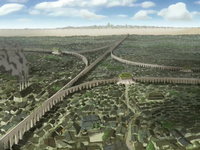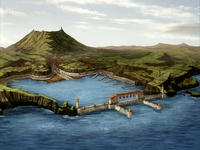| "Fire is the element of power. The people of the Fire Nation have desire and will and the energy and drive to achieve what they want. Earth is the element of substance. The people of the Earth Kingdom are diverse and strong. They are persistent and enduring. Air is the element of freedom. The Air Nomads detached themselves from worldly concerns and found peace and freedom ... Water is the element of change. The people of the Water Tribe are capable of adapting to many things. They have a deep sense of community and love that holds them together through anything." |
| — Iroh to Zuko on the people of the four nations.[1] |
The World of Avatar is divided into four nations: the Water Tribe, Earth Kingdom, Fire Nation, and Air Nomads. Each nation is culturally unique and associated with one bending technique: waterbending, earthbending, firebending, and airbending, respectively. An even distribution of power among the four nations preserves balance in the world, and a fall or increase in the strength of one nation can engender a disruptive imbalance.
Several factors determine the prosperity of the four nations, such as political balance, economic success, societal order, and spirituality. In recent history, one of the greatest threats to global stability was the Hundred Year War, in which the Fire Nation sought to dominate the other nations using military force. After the end of this conflict, relations between the different countries have significantly improved, and each of the four nations had a representative on the United Republic Council, until the council was abolished in early 171 AG.[2]
Nations
Water Tribe
- Main article: Water Tribe

The Northern Water Tribe's capital city is maintained within a wall of ice.
The Water Tribe is a sovereignty of waterbenders and other tribal people. There are three tribes: the Northern Water Tribe, centered in the North Pole; the Southern Water Tribe, centered in the South Pole; and the Foggy Swamp Tribe, located in the Earth Kingdom's Foggy Swamp. Both the Northern and Southern Water Tribes are chiefdoms led by a tribal chief. Though the Northern chief was technically the ruler of both tribes, the South maintained control of its own internal affairs[3] before ultimately gaining formal independence in 171 AG.[4] On the other hand, the Foggy Swamp Tribe seemingly lacks formal political structure, with members in several small settlements functioning without a chief.
Historically, the Northern Water Tribe has maintained a stronger position than its Southern counterpart, in part due to its large bending population, which largely remained unscathed during the Hundred Year War. In comparison, the Southern Water Tribe was devastated by numerous raids which nearly eliminated the tribe's entire bending population and destroyed its infrastructure. A relief effort led by Master Pakku in 100 AG helped restore the Southern Water Tribe to its former glory, and the settlement has since expanded to encompass a larger portion of the South Pole.
All divisions are occasionally referred to collectively as the Water Tribes. Although the Water Tribes adopted a largely isolationist policy during wartime, it welcomed outsiders following the end of the Hundred Year War. The Water Tribes also became more involved in global affairs, with each of the polar divisions having a representative on the United Republic Council prior to its dissolution.
Earth Kingdom
- Main article: Earth Kingdom

Ba Sing Se is the capital of the Earth Kingdom.
The Earth Kingdom is the largest and most diverse of the four nations, comprised of a massive continent in the eastern hemisphere and several islands. The nation's people are strong and proud, with some of them being earthbenders. The Earth Kingdom is extremely diverse, having mountainous, forested, grassland, desert, and man-conquered areas, including the vast megacity Ba Sing Se.[5] Due to its peoples' bending ability, the people of the Earth Kingdom have created magnificent structures out of stone, such as the city of Omashu.
The Earth Kingdom is run overall as a monarchy, the capital being Ba Sing Se. However, it is apparent that there are smaller regions and cities with their own rule, such as Omashu, which was ruled by King Bumi, captured by the Fire Nation, and later restored again by Bumi.
It is sometimes referred to as the Earth Nation.
Fire Nation
- Main article: Fire Nation

The Fire Nation Capital is home to the Fire Lord and the Fire Nation government.
The Fire Nation is the second largest nation and home to most known firebenders. It is located on an archipelago of islands located in the western hemisphere of the planet and is the most advanced of the four nations, with steam and gas power.[5] It started out with a huge fleet of industrial war ships,[6] and later on adopted the use of airships[7] into its military.
The Fire Nation is also diverse in landscape, featuring many volcanic islands in its archipelago and on the mainland, as well as a tropical climate. It also has the world's most popular vacation spot, Ember Island.[5]
The country is an absolute monarchy and could even be called a dictatorship. In 0 AG, the Hundred Year War was started by Fire Lord Sozin, using his country's advanced technologies.[8] During the Hundred Year War, its people were oppressed and fed propaganda by rulers Sozin, Azulon, and Ozai. However, in 100 AG, the Fire Nation's conquest was ended and a new era of peace began, with Zuko as the new leader.[9]
Air Nomads
- Main article: Air Nomads

Before its restoration after the conclusion of the Hundred Year War, the Southern Air Temple remained uninhabited after the decimation of the Air Nomads.
The Air Nomads were the collective of the airbender people. Though the people of this nation were nomadic, the Air Nomads raised children and situated their central governments in four monastic temples located at various ends of the globe, two for males and two for females.[5] The four air temples are located on small archipelagos that were Air Nomad land on the tip of mountains and, in one case, hanging under cliffs.
The Air Nomads were loosely run by elder councils, one male and one female. Their people were extremely spiritual.
In 0 AG, the Fire Nation executed a mass invasion and genocide of the Air Nomads, driving the nation into near extinction save for Avatar Aang, who managed to escape. It is sometimes referred to as the Air Nation in Fire Nation propaganda.[10] Upon its reestablishment in 171 AG, the new airbenders are widely known to be part of the Air Nation.